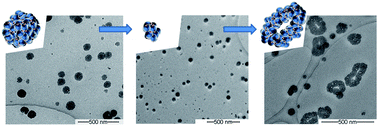Over the past 30 years, dendrimers have attracted great attention in plenty of studies stimulated by the high symmetry and monodispersity of these branched macromolecules with well-defined size and shape. Today, these dendritic structures are tailor-made for achieving specific properties and for potential applications e.g. in bionanotechnology. In this context, one pivotal key issue is the indispensable use of non-covalent interactions and forces for establishing (self-)assembled and self-organized 0D, 1D, 2D and 3D structures. The understanding and control of these non-covalent interactions is also essential for successful application of functional dendrimers in (bio-)medical applications.
In this study, the authors reported on the formation of necklace- and donut-like structures of water-soluble glycodendrimers bearing a small number of phenyl units as a time-dependent process in aqueous solution starting from self-assembled glycodendrimers to higher hierarchically assembled structures initially triggered by ultrasound treatment. For this study, they designed and synthesized new spherical poly(propylene imine) dendrimer structures by introducing on their peripheral amino groups: (i) hydrophilic bio-tolerable oligosaccharide units (maltose) and (i) hydrophobic groups (adamantyl or phenyl) capable of modifying the physical properties of these glycodendrimers. The glyco-conjugation of dendritic polyamines enabled the authors to enhance the water solubility and biocompatibility of the nanoconstructs which makes them potentially useful as drug delivery systems, therapeutic agents and artificial tubulating proteins.
Self-assembly of poly(propylene imine) glycodendrimers: role of aromatic interactions in the formation of necklace- and donut-like nanostructures by Marco Paolino, Franka Ennen, Hartmut Komber, Mihaela Cernescu, Andrea Cappelli, Bernhard Brutschy, Brigitte Voit and Dietmar Appelhans, Polym. Chem., 2012, 3, 3239-3242.
Julien Nicolas is a guest web-writer for Polymer Chemistry. He currently works at Univ. Paris-Sud (FR) as a CNRS researcher











